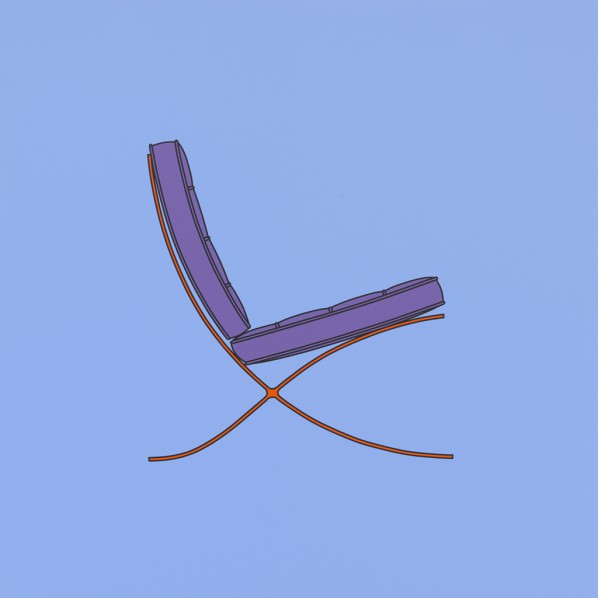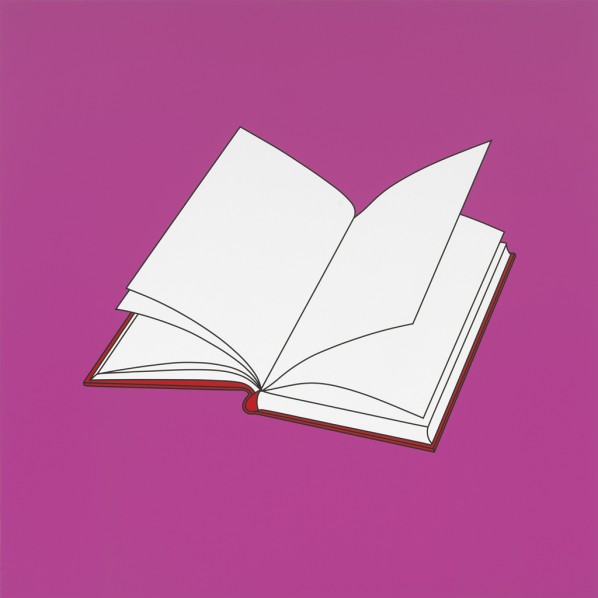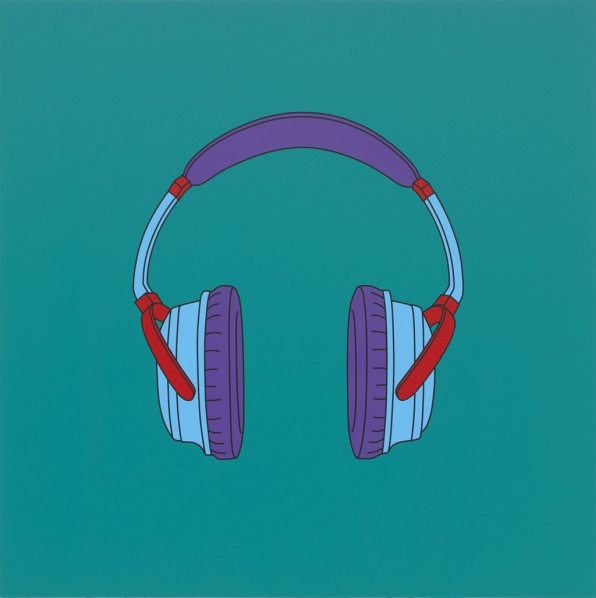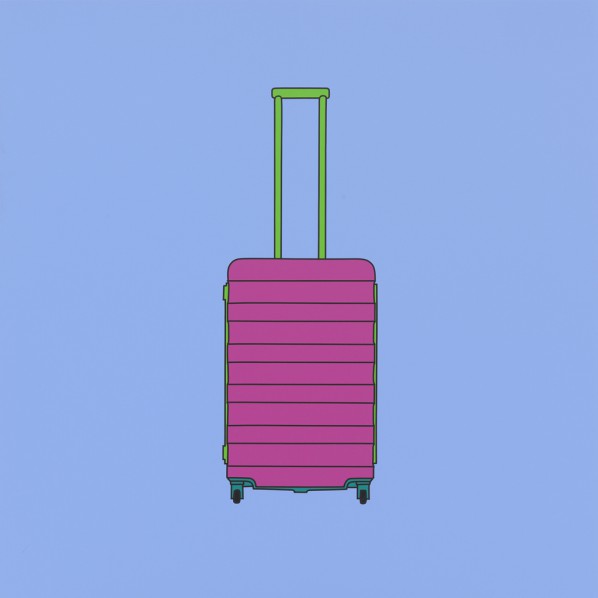
On February 2, 2015, Now – Michael Craig-Martin 2015 China Tour Exhibition 丨Shanghai opened at Shanghai Himalayas Museum. The exhibition marks a debut for Michael Craig-Martin (1941- ), a leading figure in the British contemporary scene, in mainland China. Organized by Shanghai Himalayas Museum and the Cultural and Education Section of the British Consulate-General. Now is also the inaugural event of 2015 UK-China Year of Cultural Exchange. Fifty new paintings in varying sizes, which are all painted in acrylic on aluminum, will be put on display, each with a single object from our daily lives. Collectively, they compose a story of contemporary life.

Michael Craig-Martin, Untitled (A Barcelonan Chair), acrylic on aluminum, 122 x 122 cm (no frame), 2014

Michael Craig-Martin, Untitled (A Book), acrylic on aluminum, 200 x 200 cm (no frame), 2014
Objects of our daily life are in simple shapes and bright colors which are recognized as the signature of Craig-Martin’s art. Hailed as “the high priest of ordinary things” by the Telegraph, Craig-Martin’s work is in many public collections, including the Museum of Modern Art, New York; Tate Gallery, London; and the Centre Pompidou, Paris. He also created large-scale site-specific installations with commissions from the Kunstvereins in?Dusseldorf,?Stuttgart, and Hannover and National?Art?Center?Tokyo. Born in Dublin, Craig-Martin moved to the United States with his family and studied fine art at Yale University. He returned to Europe in the mid-1960s, becoming one of the key figures of the first generation of British conceptual artists. In the late 1970s, he began to make line drawings of ordinary objects such as headphones, a chair and a paint roller, which became transformed into drawings, paintings and a steel sculpture which is rendered as concisely as possible. It’s more often that people tend to turn a blind eye to daily objects surrounding them as they take their presence and the alteration they’ve made on the world for granted. However, these easily ignored ordinary objects have remained a center of Michael Craig-Martin’s artworks for decades. According to him, “the colors are meant to convey non-visual sensations - the smell, taste, feel and sound - of the objects.” Among the exhibits for his premiere in Shanghai, common objects such as scissors, a cell phone, a skateboard and flip-flops are featured.

Michael Craig-Martin, Untitled (A Pair of Medium Headphones), acrylic on aluminum, 122 x 122 cm (no frame), 2014

Michael Craig-Martin, Untitled (A Suitcase), acrylic on aluminum, 122 x 122 cm (no frame), 2014
In addition to his achievements in the realm of art, Michael Craig-Martin is also a prominent figure in art education. He taught at Goldsmiths College in London from 1973 to 1988 and 1994 to 2000, where he was a powerful influence on a group of his students who became known as the Young British Artists, including Gary Hume, Sarah Lucas, Tracy Emin, and Damien Hirst. He also took on the role as the judge for the John Moores New Painting Prize, a?leading showcase for contemporary paintings and emerging talent.
When asked about his insight into art education, Craig-Martin said the most important thing was to encourage students “to believe in their own instincts, they have to value what they are good at. They have to understand that to carry a passion about something is essential. Many people have talent, but because they don’t have a passion, they will never work. But a person with very little power, but a lot of passion, they can succeed.”
Craig-Martin's arrival in China is a sort of homecoming for the Dublin-born artist, who claims Chinese lineage: his great-grandmother was Chinese, which makes his tour exhibition in China all the more intriguing and the inaugural event of 2015 UK-China Year of Cultural Exchange all the more special and meaningful.
During the exhibition, Michael Craig-Martin will also be engaged in a series of interactive programs with art educators and young art practitioners in China.
About the Artist
Michael Craig-Martin was born in Dublin in 1941. He moved to the United States with his family in 1945 and studied fine art at Yale University at the same time as Richard Serra, Brice Marden, and Chuck Close. He returned to Europe in the mid-1960s, becoming one of the key figures of the first generation of British conceptual artists. From 1973 to 1988 and 1994 to 2000, he taught at Goldsmiths College in London, where he was a powerful influence on a group of his students who became known as the Young British Artists, including Gary Hume, Sarah Lucas, and Damien Hirst.
From his early Minimalist box-like constructions of the late 1960s, Craig-Martin moved increasingly to the use of ordinary household objects, playing against the logic of his sources. In 1974, he exhibited his iconic work An Oak Tree (1973), which consists of a glass of water standing on a shelf high on the gallery wall. In the accompanying text, Craig-Martin asserts, through a self-administered Q&A, that despite appearances, he has changed the glass of water into an oak tree.
In the late 1970s, he began to make line drawings of ordinary objects. Over the years, he created an ever-expanding vocabulary of images, which form the foundation of his work to this day. Craig-Martin continued working in various mediums, always maintaining an elegant restraint and conceptual clarity. The focus of his work shifted decisively to painting in the 1990s, with the same range of boldly outlined motifs and luridly vivid colour schemes in unexpected combinations applied both to works on canvas and aluminium, and to increasingly complex installations of wall paintings.
Craig-Martin’s sculptures, in many ways the next iteration of his painted works, are essentially three-dimensional drawings in space of readily identifiable objects. The image of an umbrella or a light bulb is immediately identifiable by the viewer. And yet, the size, monochromatic palette, and flatness of the sculpture undermines the function and meaning of each object, urging the viewer to question what is really before him or her.
Craig-Martin’s work is in many public collections, including the Museum of Modern Art, New York; Tate Gallery, London; and the Centre Pompidou, Paris. He has had solo exhibitions at institutions across the world, including the Kunsthaus Bregenz, Austria (2006), and, most recently, the Kunstmuseen Krefeld, Germany (2013). A retrospective of his work was presented at the Whitechapel Art Gallery, London (1989), and a second at the Irish Museum of Modern Art, Dublin (2006–07). Permanent large-scale installations can be seen at the Woolwich Arsenal DLR station in the UK; the European Investment Bank, Luxembourg; and the Laban Dance Centre, Greenwich, UK, a collaboration with architects Herzog & DeMeuron. He was an Artist Trustee of the Tate from 1989 to 1999, received a CBE in 2001, and was elected to the Royal Academy of Arts in 2006. Craig-Martin lives and works in London.
About 2015 UK-China Year of Cultural Exchange
2015 sees the first ever UK-China Year of Cultural Exchange – showcasing the very best of UK culture in China and Chinese culture in the UK. A unique opportunity to further deepen and strengthen the UK’s existing relationship with China across the arts and creative industries, the 2015 UK-China Year of Cultural Exchange will build on our long and shared rich cultural histories, and seek to inspire what this creative partnership means in the 21st Century.
The Year comprises of two ‘seasons’ of culture – a UK season in China in the first half of 2015 and a China season in the UK in the second half of 2015.
The theme for the UK season in China is ‘the Next Generation’, with a contemporary, adventurous, multi-disciplinary and innovative program of around 30 projects across China. Through these projects, and supporting dialogues and visits between professionals, the Year showcases the diversity and excitement of the UK's creative, cultural sector and of many fine artists. This is supported by a significant digital offering, including on social media and a new digital arts platform, for showcasing and for connecting all those interested in the two cultures, and how the UK and China work together.
Now – Michael Craig-Martin 2015 China Tour Exhibition 丨Shanghai, organised by Shanghai Himalayas Museum and the Cultural and Education Section of British Consulate-General, marks the beginning of 2015 UK-China Year of Cultural Exchange.About the Exhibition
Now—Michael Craig-Martin 2015 China Tour Exhibition | ShanghaiOrganizers:?Shanghai?Himalayas?Museum, Cultural?and?Education?Section?of?the?British?Consulate-General
In?collaboration?with?Gagosian?Gallery?and?Holtermann?Fine?Art
Opening: 5:00pm, Feb. 2, 2015 (Mon.)
Dates: Feb. 3 - Mar. 31, 2015
Venue: Shanghai Himalayas Museum
Courtesy of the artist and Shanghai Himalayas Museum, for further information please visit www.himalayasart.cn.




























